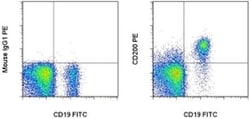Learn More
Invitrogen™ CD200 Monoclonal Antibody (OX104), PE, eBioscience™
Mouse Monoclonal Antibody
$140.00 - $333.00
Specifications
| Antigen | CD200 |
|---|---|
| Clone | OX104 |
| Concentration | 5 μL/Test |
| Content And Storage | 4°C, store in dark, DO NOT FREEZE! |
| Applications | Flow Cytometry |
| Catalog Number | Mfr. No. | Quantity | Price | Quantity & Availability | |||||
|---|---|---|---|---|---|---|---|---|---|
| Catalog Number | Mfr. No. | Quantity | Price | Quantity & Availability | |||||
12-920-041

|
Invitrogen™
12920041 |
25 Tests |
Each for $140.00
|

|
|||||
50-113-0695

|
Invitrogen™
12920042 |
100 Tests |
Each for $333.00
|
|
|||||
Description
Description: The monoclonal antibody OX104 recognizes human CD200 also known as OX2. CD200 is a member of the Ig superfamily with 2 Ig domains, a transmembrane and cytoplasmic domain. CD200 is expressed on resting and activated B cells, a subset of resting and activated T cells, keratinocytes, peripheral and central nerve cells, follicular dendritic cells and ovarian cells. The interaction with CD200R results in macrophage activation (IL-6 production), inhibition of mast cell degranulation along with reduced TNF alpha and IL-13 secretion and overall attenuation of the activation status of lymphocytes. A role has also been suggested in maternal tolerance as expression of CD200 is also present on the trophoblast. Applications Reported: This OX104 antibody has been reported for use in flow cytometric analysis. Applications Tested: This OX104 antibody has been pre-titrated and tested by flow cytometric analysis of normal human peripheral blood cells. This can be used at 5 μL (0.25 μg) per test. A test is defined as the amount (μg) of antibody that will stain a cell sample in a final volume of 100 μL. Cell number should be determined empirically but can range from 10^5 to 10^8 cells/test. Excitation: 488-561 nm; Emission: 578 nm; Laser: Blue Laser, Green Laser, Yellow-Green Laser. Filtration: 0.2 μm post-manufacturing filtered.
CD200 is a type-1 membrane glycoprotein in the immunoglobulin superfamily, featuring two immunoglobulin domains. It is widely expressed on various cells, including B and T cells, keratinocytes, nerve cells, follicular dendritic cells, ovarian cells, and trophoblasts. CD200 interacts with CD200R on myeloid cells, inhibiting macrophage activation, reducing IL-6 production, and attenuating lymphocyte activation. It also prevents mast cell degranulation and decreases TNF-alpha and IL-13 secretion, playing a role in immune regulation and maternal tolerance. Homologues of CD200 are found in herpesviruses and poxviruses, indicating a conserved immune modulation function. CD200 has multiple alternatively spliced transcript variants, contributing to its functional diversity. Diseases linked to CD200 dysfunction include Mantle Cell Lymphoma and Primary Hypertrophic Osteoarthropathy, highlighting its importance in health and disease.Specifications
| CD200 | |
| 5 μL/Test | |
| Flow Cytometry | |
| PE | |
| Mouse | |
| RUO | |
| PBS with BSA and 0.09% sodium azide; pH 7.2 | |
| P41217 | |
| 4345 | |
| Primary | |
| Affinity Chromatography |
| OX104 | |
| 4°C, store in dark, DO NOT FREEZE! | |
| Monoclonal | |
| Liquid | |
| IgG1 κ | |
| Human | |
| Cd200 | |
| antigen identified by monoclonal antibody MRC OX-2; CD200; Cd200 antigen; Cd200 molecule; cell surface protein (thymocyte antigen identified by monoclonal antibody MRC-OX2); Cspmo2; hypothetical protein LOC534910; MOX1; MOX2; MRC; MRC OX-2 antigen; MRCOX2; My033; OX2; OX-2; OX-2 membrane glycoprotein | |
| Cd200 | |
| Antibody |
The Fisher Scientific Encompass Program offers items which are not part of our distribution portfolio. These products typically do not have pictures or detailed descriptions. However, we are committed to improving your shopping experience. Please use the form below to provide feedback related to the content on this product.
